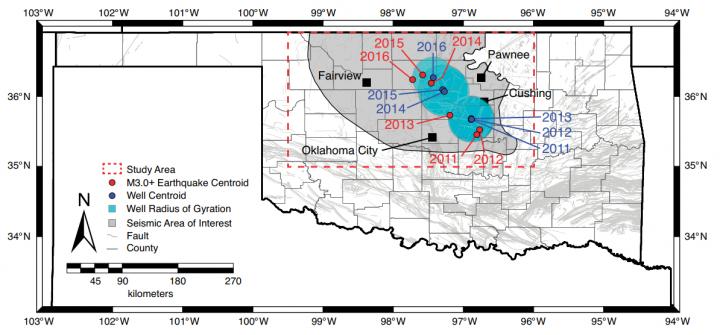Shakedown in Oklahoma: To cut the number of bigger earthquakes, inject less saltwater

Figure 2 from Pollyea et al., Annual geographic centroid locations for the years 2011-2016 (the underlying fault map is by Marsh and Holland, 2016), including volume-weighted well centroids, the 1σ radius of gyration, and M3+ earthquake centroids. Credit: Pollyea et al. and Geology
Starting around 2009, saltwater disposal (SWD) volume began increasing dramatically as unconventional oil and gas production increased rapidly throughout Oklahoma. As a result, the number of magnitude 3-plus earthquakes rattling the state has jumped from about one per year before 2011 to more than 900 in 2015. “Fluids are basically lubricating existing faults,” Pollyea explains. Oklahoma is now the most seismically active state in the lower 48 United States.
Previous studies linked Oklahoma SWD wells and seismic activity in time. Instead, Pollyea and colleagues studied that correlation in space, analyzing earthquake epicenters and SWD well locations. The team focused on the Arbuckle Group, a porous geologic formation in north-central Oklahoma used extensively for saltwater disposal. The earthquakes originate in the basement rock directly below the Arbuckle, at a depth of 4 to 8 kilometers.
The correlation was clear: “When we plotted the average annual well locations and earthquake epicenters, they moved together in space,” says Pollyea. The researchers also found that SWD volume and earthquake occurrence are spatially correlated up to 125 km. That's the distance within which there seems to be a connection between injection volume, fluid movement, and earthquake occurrence.
By separating data by year from 2011 through 2016, Pollyea and colleagues also found that the spatial correlation for smaller earthquakes weakened in 2016, when new regulations reduced pumping volumes. Yet the spatial correlation for M3.0+ earthquakes persists unabated. In fact, two particularly alarming earthquakes shook the region in September 2016 and November 2016. The first, M5.8, was the largest ever recorded in Oklahoma. The second, M5.0, rocked the area surrounding the nation's largest oil storage facility, containing millions of barrels of oil.
Pollyea's theory for why reduced fluid pressure has only affected small faults: “It's like the traffic on the freeway is still moving, but the smaller arterials are cut off.” He emphasizes that so far, they can't predict single earthquakes or even blame specific wells for specific shaking. But to reduce large fluid-triggered earthquakes, Pollyea concludes, “It appears that the way to do it is to inject less water.”
Image: Figure 2 from Pollyea et al., Annual geographic centroid locations for the years 2011-2016 (the underlying fault map is by Marsh and Holland, 2016), including volume-weighted well centroids, the 1σ radius of gyration, and M3+ earthquake centroids.
###
FEATURED ARTICLE
Geospatial analysis of Oklahoma (USA) earthquakes (2011-2016): Quantifying the limits of regional-scale earthquake mitigation measures Authors: Ryan M. Pollyea (Virginia Tech; rpollyea@vt.edu); Neda Mohammadi; John E. Taylor; Martin C. Chapman; https:/
GEOLOGY articles are online http://geology.
Media Contact
More Information:
http://www.geosociety.org/GSA/News/pr/2018/18-01.aspxAll latest news from the category: Earth Sciences
Earth Sciences (also referred to as Geosciences), which deals with basic issues surrounding our planet, plays a vital role in the area of energy and raw materials supply.
Earth Sciences comprises subjects such as geology, geography, geological informatics, paleontology, mineralogy, petrography, crystallography, geophysics, geodesy, glaciology, cartography, photogrammetry, meteorology and seismology, early-warning systems, earthquake research and polar research.
Newest articles

NASA: Mystery of life’s handedness deepens
The mystery of why life uses molecules with specific orientations has deepened with a NASA-funded discovery that RNA — a key molecule thought to have potentially held the instructions for…

What are the effects of historic lithium mining on water quality?
Study reveals low levels of common contaminants but high levels of other elements in waters associated with an abandoned lithium mine. Lithium ore and mining waste from a historic lithium…

Quantum-inspired design boosts efficiency of heat-to-electricity conversion
Rice engineers take unconventional route to improving thermophotovoltaic systems. Researchers at Rice University have found a new way to improve a key element of thermophotovoltaic (TPV) systems, which convert heat…



